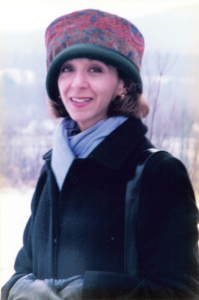About
 Some of my earliest memories—at least, the memories filtered through words—have to do with the competing narratives, conflicting optics, and blended tones that co-existed within a single story, that complicated the telling of apparently simple anecdotes. I grew up in a highly verbal, contentious, polyglot family (our home language was primarily English, but there were also Sicilian, High Italian, Yiddish and French), and from a young age, I reflexively translated back and forth. The first time I saw my mother deliberately mistranslate Italian to serve her own ends in an argument was a startling revelation about the multiple possibilities, and powers, of interpretation. I gleaned very early that in order to get the “right” story you needed the “right” language.
Some of my earliest memories—at least, the memories filtered through words—have to do with the competing narratives, conflicting optics, and blended tones that co-existed within a single story, that complicated the telling of apparently simple anecdotes. I grew up in a highly verbal, contentious, polyglot family (our home language was primarily English, but there were also Sicilian, High Italian, Yiddish and French), and from a young age, I reflexively translated back and forth. The first time I saw my mother deliberately mistranslate Italian to serve her own ends in an argument was a startling revelation about the multiple possibilities, and powers, of interpretation. I gleaned very early that in order to get the “right” story you needed the “right” language.
I could only have become a writer, and from the beginning my literary interests have had to do with languages-within-languages, and/or “pockets” of culture within larger cultures: Catalan, Ladino (a language of Sephardic Jews, a marriage of Hebrew and Spanish). Liliane Atlan, whose plays I have translated, writes in a French inflected with the dialects of her parents, who were Greek Jews. My earliest translations were of the poetry of Léopold Sédar Senghor and Aimé Césaire, who in their separate ways transformed the elements of French verse—iconoclasts from the colonies who soon enough became classics in the metropolis. It may seem like I’m all over the proverbial map—and that, I think, is as true as it is false. As I look back on a lifetime of writing, I can see essential commonalities in my far-flung writing and translation projects: individual lives churned up by the upheavals of history; hiding and emigration; salvage and rescue.
I have long been concerned with how disaster—and the memory and dread of disaster—affect our relationship to language: to narrative form, the making of images, the rhetorical framing of theatre. The geographic and historical locus of these concerns would—again by chance?—shift for me in the mid-1980s when friends in Paris urged me to consider translating the work of Argentine playwright and novelist Griselda Gambaro whose work addressed, in groundbreaking ways, the theatricality of political terror. One of the most important Latin American playwrights of this century, Gambaro was forced into exile in 1977 when then de facto president Jorge Videla personally banned one of her books—which was, of course, a death threat. I needed to explore firsthand the work that had given rise to Griselda’s extraordinary plays. My relationship with Griselda and her work lead me to straight to A Lexicon of Terror: Argentina and the Legacies of Torture.
A Lexicon of Terror brought together everything I’d worked on to that point: research and testimony; argument and description; character and place; pacing, framing, and the orchestration of a multitude of voices in an overarching narrative that moves through time—with an absolute fealty to the rigors of nonfiction. The research was of course done in Spanish, but I wrote the book in English; the translation of testimony, interviews, and documents being an integral part of this project.
And now I seem to have come full circle with Anna, Who Did Not Believe in the Sea, the original novel I am in the process of completing. Also in the works is a translation (for the University of Texas Press) of Pillar of Salt, the long-suppressed memoir by the incomparable Mexican poet and essayist Salvador Novo (1904-1974), followed by nineteen sonnets.
